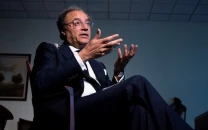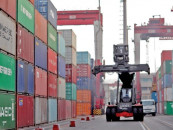Reserves hit 3-year high at $16.9b
No rate cut expected by analysts but survey sees inflation at 6-8%

Pakistan's total liquid foreign exchange reserves have surged to $16.88 billion — the highest level in 163 weeks, last recorded on April 16, 2022.
Speaking to The Express Tribune, Deputy Head of Trading at Arif Habib Limited (AHL), Ali Najib said, "Of this, the State Bank of Pakistan (SBP) holds $11.68 billion, marking a 20-week high last seen on January 20, 2025, while commercial banks maintain reserves of $5.20 billion."
The SBP's foreign exchange reserves rose by $167 million during the week ended June 6, 2025, according to data released by the central bank on Thursday. This represents a weekly increase of $277 million and a fiscal year-to-date (FYTD) rise of $2.88 billion, he said in his commentary. As a result, the country's import cover has improved to 1.94 months, up from 1.91 months previously.
The surge in reserves is attributed to stronger export performance, robust remittance inflows, and financial support from the International Monetary Fund (IMF) as well as bilateral partners.
"This boosts investor confidence, strengthens the rupee, and enhances the country's ability to pay for imports and service debt," said Najib. This improvement also lowers default risk and supports inflation stability, contributing positively to the overall macroeconomic environment.
The central bank announced that the Monetary Policy Committee (MPC) of SBP will meet on Monday, June 16, 2025, to decide about the monetary policy.
In a poll conducted by Topline Securities, 56% of market participants expect the central bank to maintain the current policy rate in the upcoming meeting, a notable increase from 31% in the previous poll. Meanwhile, 44% anticipate a policy rate cut of at least 50 basis points (bps). Within this group, 19% foresee a 50bps reduction, while 25% expect a more aggressive cut of 100bps.
Despite the market's mixed expectations, Topline Research believes that the central bank has room for a further cut of around 100bps, considering that average inflation for FY26 is projected to remain between 6-7%. This would translate into a real interest rate of 400-500bps — well above the historical range of 200-300bps — assuming a policy rate of 11%.
However, the SBP is widely expected to maintain a status quo in its upcoming monetary policy meeting amid persisting uncertainties on both domestic and global fronts. A key concern influencing this cautious stance is the recent rebound in international crude oil prices, which have surged to the $68-70 per barrel range due to heightened geopolitical tensions in the Middle East and the possibility of a US-China trade agreement.
Given that global oil prices have historically played a significant role in driving domestic inflation, this development is likely to compel the central bank to adopt a wait-and-see approach. Moreover, the potential inflationary impact of upcoming domestic adjustments — such as anticipated notifications regarding gas and electricity tariff hikes — remains unassessed and yet to be absorbed by the market. These factors, combined, support the likelihood of the SBP keeping its policy rate unchanged in the near term.
Minutes from the last MPC meeting held on May 5, 2025, revealed that eight out of nine members favoured a 100-basis points rate cut. However, since that easing, yields on the six-month Karachi Interbank Offered Rate (KIBOR) and six-month T-bills have increased by 88-99 basis points. Currently, the six-month KIBOR and T-bills stand at 11.09% and 10.95%, respectively.
As per the Topline survey, inflation is expected by most respondents to average 6-8%, with the rupee projected to settle between Rs280-290 per US dollar by year-end. Meanwhile, the rupee depreciated for a second straight session, closing at 282.67 per dollar, while domestic gold prices jumped by Rs4,000 per tola to Rs356,900, following international gains.



















COMMENTS
Comments are moderated and generally will be posted if they are on-topic and not abusive.
For more information, please see our Comments FAQ